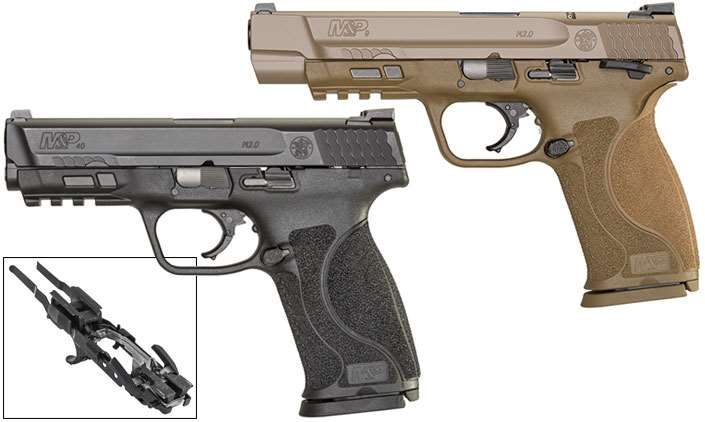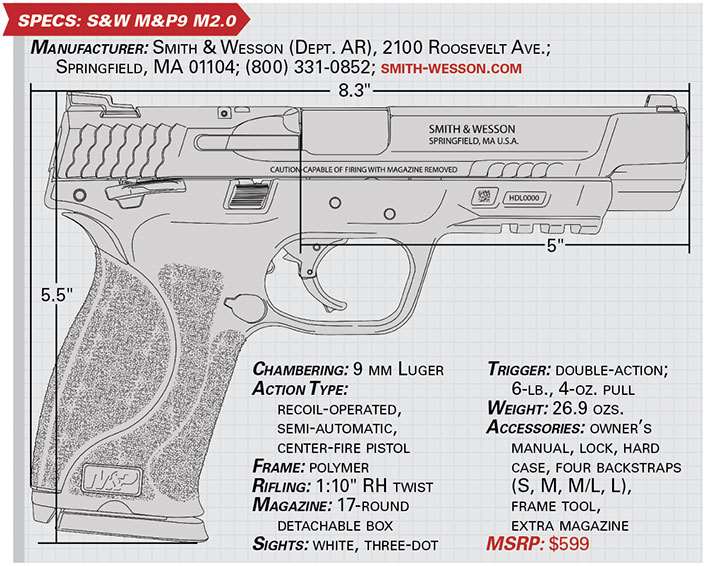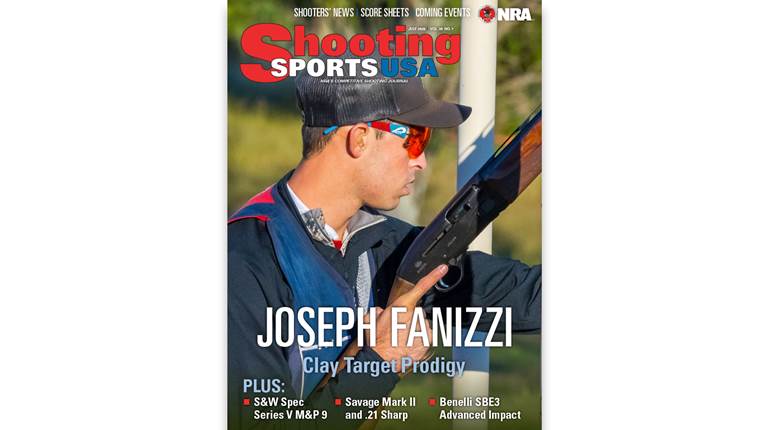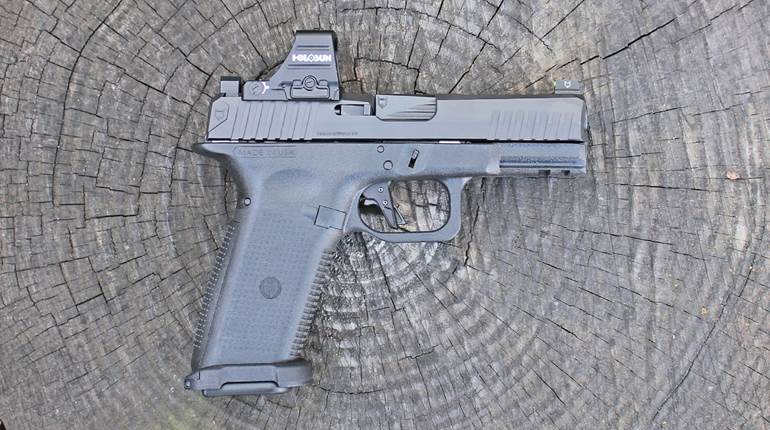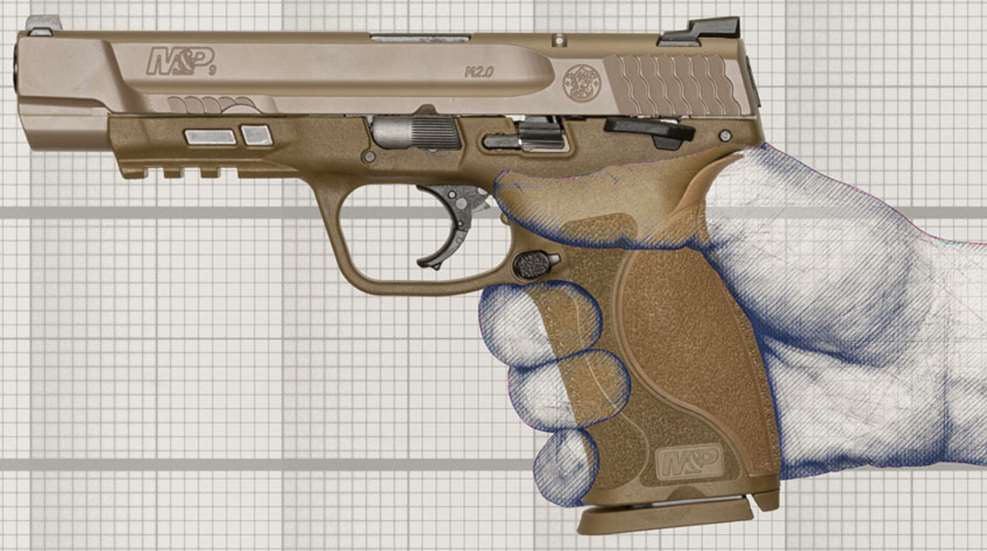
A couple of weeks before last Christmas, I traveled to Springfield, Mass., to unwrap a raft of new presents placed tantalizingly under the wide-reaching boughs of the American Outdoor Brands Corp. tree. While many of the things presented to gun writers at the event were interesting, some were mere stocking stuffers, as it were, while others were the kind that could make a full-grown firearm enthusiast whoop and holler with childlike joy—if only on the inside, of course. Of the latter, one stood out from the rest because of the significance of its name, Smith & Wesson—one of America’s most recognizable, dating back to 1852—and, more to the point, because it flies the Military & Police banner that, for 108 years, has come to represent the best S&W has to offer. Of course, that first “M&P” was a revolver, the classic handgun type for which the name Smith & Wesson is synonymous. The steel-and-walnut Model 10, alternately known as the Hand Ejector and, in a slightly different form, Military & Police, had an excellent feel in the hand, a smooth action and, in some cases, practical touches such as a Parkerized finish and a lanyard ring. It was the high-tech service handgun of its era. In fact, another of its monikers, Victory, may have been the most apropos in describing the future success the first M&P was to enjoy in the American law enforcement market. It heralded a future that today rests securely in a line of self-loading polymer handguns and forged aluminum AR-style rifles.
It’s worth remembering that the Germans paved the way for polymer handguns in the 1970s and that, in 1982, a certain Austrian pistol came along that thoroughly crashed the party for law enforcement personnel who had, up to that point, been hosted almost exclusively by Smith & Wesson and another famous Connecticut River Valley revolver firm for the better part of a century. In 1994, S&W attempted to counter the European invasion with its Sigma series of polymer-frame handguns, which, much to the company’s chagrin, became entangled in legal accusations of imitation and were generally panned by the public. Then, in 2000, a joint venture between S&W and Walther resulted in the polymer-frame SW99, which, while short-lived, indicated that S&W was intent on success in that segment of the market. Finally, in 2005, the firm reclaimed its former glory among lawmen with a brand new polymer-frame, striker-fired semi-automatic pistol all its own called the M&P and well-deserving of what was then a dormant but fondly remembered mantle (March 2006, p. 36).
The gun quickly proved to be competitive with all comers, foreign and domestic, by incorporating the latest advances in technology, and by possessing one undeniable, often underrated, feature: an extraordinarily natural fit in the hand. According to Jan Mladek, general manager of the S&W and M&P brands, “During the design phase of the original M&P pistol, there was a lot of effort put into researching the ideal fit and function. We solicited feedback from a wide-ranging user group, including different segments of the professional community.” Not only was the gun’s grip shape comfortable, it could be adapted somewhat to fit various hand sizes by way of interchangeable inserts that filled nearly the entire palm. At the time, even now, many makers reserved such modularity for the backstrap alone. But on the M&P, the textured inserts formed significant segments that wrapped halfway around the grip. More importantly, they seemed to possess just the right amount of arch and palm swell, so that—along with the grip’s 18-degree angle, its high position relative to the bore axis, and its shallow beavertail and undercut at the trigger guard—the M&P’s ergonomics were, in a word, exceptional. And exceptional ergonomics went a long way toward fine shootability.
In the decade since the first polymer M&P, the gun’s adaptability, handling characteristics and manufacturing quality helped restore Smith & Wesson’s reputation as the major player it had been for so long in the law enforcement market—and certainly didn’t hurt its reputation with civilians, either. But as with all good companies, S&W didn’t see its success as a reason to rest on its laurels. Behind the scenes, it took notes from users, compiling a list of enhancements that it intended to incorporate when the time was right to upgrade the M&P. The results were wrapped up as the fabled “big present under the tree” at the aforementioned writer event and became known to the public at the beginning of this year. As the gun’s name, M&P M2.0, indicates, it is a revision of the first polymer M&P, which should be comforting to those for whom the M&P “M1.0” represents the pinnacle in polymer pistol production. In fact, the first model will indeed continue in production alongside the new gun.
So, now that we’re fully into the summer season and the new M&P M2.0s are coming online, what’s different about them from the earlier generation? Actually, before getting to that, it’s worth mentioning, particularly for S&W devotees, three important aspects that remain similar enough that they lend compatibility between the generations: The magazines for earlier M&P pistols fit and function in the new guns and vice versa. Also, sight dovetail dimensions are the same. And holsters for first-generation guns will accommodate second-generation guns—although the reverse may or may not be true given the new guns’ somewhat more slender slide contours. As to the changes, there are two that involve the grip. And, rest assured, they do not affect its angle or basic shape, which are generally acknowledged as the pistol’s best ergonomic feature.
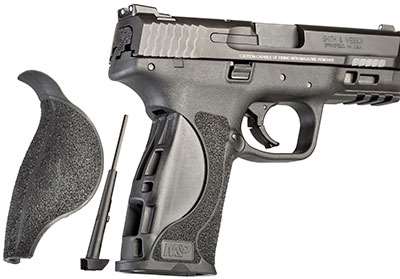
First is more aggressive stippling on the grip frame similar in texture to that of skateboard tape, which for years was used by competitive shooters to enhance purchase on so-called race guns. It differs from the smoother “orange peel”-like surface of earlier models in that it adheres to the hand better when the skin is wet or the grip is somewhat loose. Second is a fourth grip insert, which further expands the potential range of hands that the gun is likely to fit well. The new size, identified as “M/L” on the lower, center area of the insert itself, complements the existing “S,” “M” and “L” sizes, splitting the difference between the latter two. Carried over from the earlier M&P is a frame tool for backstrap removal/installation that cleverly stores within the grip frame and upholds the M&P tradition by serving as a lanyard attachment point. To use it, simply remove the magazine, turn the tool 90 degrees and withdraw it from the frame. Backstraps can then be changed out before re-installing the tool in the reverse manner.
Another significant difference in the M&P M2.0 involves the trigger mechanism, which is lighter and crisper than that of previous models. As in the earlier M&P, the design can be considered “double-action” by virtue of the fact that the trigger stroke completes the cocking of the striker spring—mostly accomplished by the slide as a cartridge is being chambered—and then releases the sear. The trigger pull on the new gun averages around 6 lbs., 4 ozs., or about 8 ozs. lighter than earlier designs. Also, the trigger’s reset position has been shortened and is more distinct in both tactile and audible senses. Mladek attributed the improvements to “direct contact between the trigger bar and the sear during the trigger stroke and geometry changes to the striker.” Yet another notable improvement to the gun that is not readily apparent is a re-design of its rigid stainless steel chassis, which constitutes the serialized frame proper. It is permanently molded into the polymer frame along most of its 7" length, further reinforcing it and providing mounting points for various cross pins.
Regarding the size of the new guns, it’s worth pointing out that, as this is written, M2.0 models are not yet available in compact versions as is the earlier M&P. All current M2.0s share a full-size frame although, depending on the model, several barrel lengths are employed. As an example, the 9 mm Luger model with a 4.25" rather than 5" barrel yields an overall length of 7.4" instead of 8.3", although magazine capacity and overall height are identical. Weight, at 24.7 ozs. for the shorter version, is a mere 2.2 ozs. lighter—seemingly a trifle, but a consideration nonetheless for everyday concealed carry. (S&W fans who must have a subcompact double-stack can find it in first-generation M&P "C" models, and even smaller, lighter, thinner guns are offered in the Shield line.) The difference in overall width between M2.0 models without manual safety levers and those with them amounts to approximately two-tenths of an inch, with the latter measuring 1.5". The buyer will have to make such choices, but for those who prefer a full-height grip frame and a double-stack magazine, the shorter M&P9 M2.0 could be granted an advantage for its barrel’s tendency to clear leather just a bit smoother and sooner. Someone trained to rotate the muzzle toward the target at the earliest possible opportunity during the draw, particularly in the event of a contact-distance encounter, may appreciate such an advantage.
Regardless of size, the new M&P’s mechanical operation follows the earlier version’s tried-and-true pattern: a tilting barrel—made of stainless steel with a flat-black nitride treatment for corrosion-resistance and surface hardness that S&W refers to as Armornite—locks into battery when its hood rises into the slide’s ejection port as a round is chambered. Upon firing, recoil sends the locked barrel and slide, also Armornite-treated stainless steel, rearward a short distance before a steel locking block pinned to the frame cams the barrel’s underlug downward. (The block also forms the rails on which the slide’s grooves reciprocate.) The slide then continues rearward where its pivoting external extractor and fixed ejector expel the cartridge case before the now-compressed flat-wire recoil spring sends it forward again to pick up a fresh round from the magazine and return the barrel fully into battery. A second steel block at the frame’s rear features additional sections of slide rail and locates pins on which the sear and manual safety levers pivot.
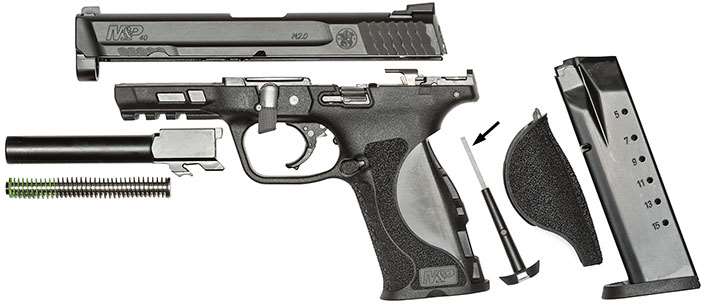
Also carried over from the earlier M&P is its passive trigger safety. As opposed to some such designs, the M&P trigger consists of a jointed bow that straightens as finger pressure is applied, allowing a ledge on its lower section to clear an opening in the frame and freeing the upper section to pivot. That draws a trigger bar forward and completes the striker spring’s compression before releasing the sear to send the striker forward. A plunger-style striker-block safety, mounted in the slide, prevents the striker from moving forward unless the plunger is raised by a tab on the trigger bar, which can only occur when the trigger is pulled fully to the rear. Other safeties include an out-of-battery disconnector safety and a sear-deactivation lever that can be tipped into the magazine well with the frame tool to allow field-stripping—initiated by locking the slide back and rotating the takedown lever on the frame’s left side—without pulling the trigger. A loaded-chamber witness hole at the top rear center of the barrel is used on all models, but those destined for sale in California additionally feature a lever recessed into the slide farther rearward that rests in the hole when a cartridge is not present. When one is, it rises to provide tactile and, by way of red areas on each side, visual indications of the gun’s condition.
The slide lock is bilateral and has been changed from previous models in that it has a small spring-loaded tab on the frame’s left side that maintains its position, up or down, more positively. Apparently, some users complained that it could be inadvertently activated while shooting. The sample 5"-barreled flat dark earth pistol chambered in 9 mm Luger, featured the optional, bilateral manual safety with extended, polymer-clad levers. As on all models, its all-steel magazine release depressed in one direction only, but is reversible and engages cutouts in the magazine body’s front corners. A row of witness holes in each side of the magazine body is numbered “4” through “16” on the right side and “5” through “17” on the left. Ten-round versions are available in localities that require such, and two magazines come with each pistol. Depressions on each side of the gun’s grip frame aid in pulling them free, although they fall free under normal circumstances. Perhaps the two most noticeable exterior changes are the re-sculpted slide and the addition of a small section of grasping grooves at its front in the company’s familiar stepped “wave” pattern. Scalloped areas approximately 9/16"-wide across the slide’s middle reduce its width from a point at the rear of the slide lock to nearly the rear of the front sight, rendering it 0.20" narrower than at its base—width of the 9 mm Luger-chambered pistol across the slide is 0.90" at the narrowest portion and 1.10" at the widest. The
.40 S&W slide measures 1.02" and 1.10", respectively.
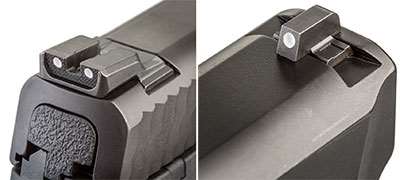
Shooting the new M&P, while not a revelation, nonetheless proved a pleasant experience that vindicates S&W engineers’ sensible improvements to an already well-received pistol. For instance, the grip frame has even less tendency to shift in the hand during firing. The trigger has a commendably crisp and comparatively light break after approximately 1/2" of staged travel with its reset point occurring early, after about 1/4" of forward travel. “Press checks,” wherein the slide is retracted slightly using the off hand to confirm a round in the chamber, are more easily facilitated by the front grasping grooves. Finally, the grooves along the slide’s top corners seem to allow the pistol to clear leather a bit easier, speeding presentations and easing re-holstering.
Accuracy for the new gun is excellent, as the accompanying table indicates. The sights, which are both dovetailed into the slide, consist of a rear unit that is locked with a set screw and features distinct white dots on either side of a serrated, recessed face with a square notch cutout. It can be used to rack the slide by catching its flat front face on the edge of a hard object. The front sight also has a white dot, and its 0.132"-wide blade allows for enough light on either side that alignment with the rear sight is fast and easy. The full-size (5"-barreled), flat dark earth test gun, chambered in 9 mm Luger, turned in an average extreme spread for all three loads of 2.52", which is commendable considering the range of bullet weights and velocities represented. In fact, the most compatible load’s smallest group of 1.33" is excellent for an out-of-the-box service pistol. Even when shooting the 4.25"-barreled model in .40 S&W, I found that keeping all my shots within a 4" bullseye at 10 yds.—while stepping rapidly toward and away from the target to simulate advancing and retreating movement in a dynamic confrontation—was well within the capabilities of the pistol’s sights and handling qualities.
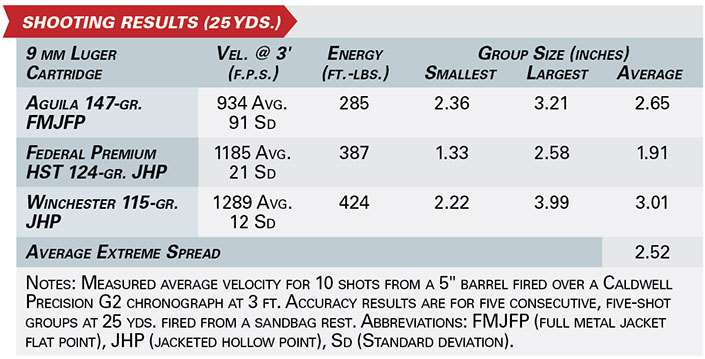
While on the topic of chamberings, note that the M2.0 is currently available in 9 mm Luger and .40 S&W, with .45 ACP in the offing. (A 4.6"-barreled .45 ACP weighing 27 ozs. is already listed on the company’s website.) Combine that with choices of external safety levers and both black and flat dark earth colors, and it’s clear that the M&P M2.0 already constitutes a family of firearms.
All in all, I found the M&P M2.0 to be highly functional, user-friendly and on-par with the other major players in the service-quality, polymer-handgun segment of the market. Smith has done a fine job elevating an established platform while preserving its strong points. According to Mladek, “Since launch in January, many law enforcement agencies have expressed interest in testing and evaluating the M&P M2.0 pistol. Feedback has been positive, and the enhancements in the M2.0 are clearly recognized.”
For the many civilian shooters who have already hitched their wagons to the Smith & Wesson brand—and to the M&P banner and the polymer pistols that represent it—the M&P M2.0 should prove pleasantly reassuring. And for those looking for a first-time carry gun or home-defense pistol, one that is the standard-bearer for a major company, has a successful history and is eminently comfortable in the hand, the M2.0 will likely be perceived as a nice surprise. In fact, the M&P M2.0 may just turn out to be the best gift to come from Springfield, Mass., in quite some time—regardless of the season.
